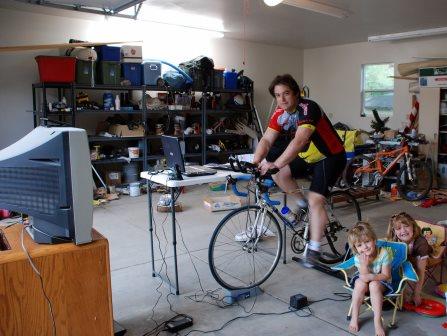When you are training for a big event, finding the time to fit in some quality riding can be frustrating, especially in the winter. Late sunrises, early sunsets, and terrible weather conditions all work to take away cycling opportunities (as well as motivation!), making the desire to train impossibly low. But there is a solution to the winter cycling blues – indoor cycling training! It may seem like a crazy concept, but many coaches actually implement indoor cycling routines into off-season cycling workouts (as well as during the season) as indoor cycling equipment can open up a new world of training when you just can’t get outside. Indoor cycling training equipment works to focus specific exercises, techniques and disciplines and they can help to accurately control workload too, so the benefits are virtually endless. Getting to grips with indoor cycling training doesn’t have to be complicated, so let’s take a look!
Rollers
Rollers are an age-old solution to cycling indoors, allowing your bike to ride continuously without actually moving forward. Rollers consist of three round cylinders that are mounted on bearings, and these are fixed onto a frame. A belt then connects one of the rear cylinders to the front cylinder, to allow the front wheel of the bike to spin at the same speed as the back wheel. You simply place your bike onto the rollers and ride.
Rollers are a great indoor cycling tool if you are looking to sharpen your bike-handling abilities because your bike is not actually affixed to the machine! This means that you must rely not just on perfect balance, but on skillful steering too. Some cyclists opt to add a fan or magnetic unit to rollers to create resistance, as there isn’t a lot of resistance generated by the rollers alone.
Types of Trainers
Wind (or turbo) style trainers typically have two fans with slotted blades. These slots work to churn the air, effectively mimicking the natural resistance that you experience when riding a traditional bike. Many cyclists feel that keeping indoor cycling training as close to the real thing is better for synchronicity and motivation, but almost as many cyclists are turning to magnetic trainers for the ability to adjust resistance.
Magnetic (or mag) trainers use powerful magnets and a non-conductive disk to produce resistance when you cycle indoors. Performance magnetic trainers typically have six resistance settings, from low to high, and are controlled by a handle bar-mounted lever that you can adjust. Many magnetic training units have incorporated small, precisely weighted flywheels in order to create a slight coasting sensation for cyclists who prefer a more realistic road feel.
The great thing about magnetic trainers is that the resistance generated when you ride increases in direct proportion to the speed in which you ride. This may be less realistic than riding a real bike, but strong resistance will both elevate your heart rate and exert your body, which will help to raise your overall endurance and fitness levels. When fitted with a flywheel, they can also help you to determine, and work through, the dead spots in your pedal stroke.
Fluid trainers are another option to increase the resistance on the rear wheel while cycling indoors. Fluid trainers use, exactly that, fluid, inside a drum that has fan blades that turn through it. The advantage with fluid is that it can offer a higher resistance and a smoother feel especially under high loads.
Using the Right Bike
As enormous pressures will be generated by each of these types of trainers, it is best to use an older bike to train indoors if possible. The bike you use is likely to rust, the headset will get grooved and many more problems can occur, so be sure to set up your bike in the same way as the one you ride for the best results.
Indoor Cycling Training Workouts
As with any form of exercise, always spend a few minutes warming up and cooling down when you use your indoor trainer. Before you get to grips with indoor training:
· Use a fan (or ride in the coolest part of your house) to avoid overheating
· Always fill your water bottle before you start your workout
· Don’t spend more than two hours at a time on your trainer
For general conditioning:
After you have warmed up, raise your riding cadence to 85 to 100 rpm. Work to maintain your heart rate at no more than 85 percent of your maximum.
For climbing strength:
Put your bike into a low gear or increase the resistance on your trainer (for mags only), to a level that will force you to drop your riding cadence to around 60 to 70rpm. Maintain this cadence for a few minutes before going back to your normal cycling rate. Repeat this throughout your training session.
For speed work:
To boost your anaerobic capacity, work on your trainer in intervals. You can work to structure interval programs, similar to those that you may use during an outdoor cycle exercise routine, to really increase your capacity for speed.
One of the most common excuses for not riding indoors is boredom. Yes, indoor cycling training can be boring but there are a few ways to better pass the time. One is simply to ride with other people so you have someone to talk to while you both get a good workout in. Whether riding with someone or on your own, incorporating intervals will break up the time and make it go faster. Entertainment wise, choose upbeat music to keep you motivated or an engaging podcast that keeps you entertained. Bike racing films or old races can also be fun to watch and added motivation. Keep it consistent and you’ll arrive outside in better shape than you thought was possible with a long, cold winter.
